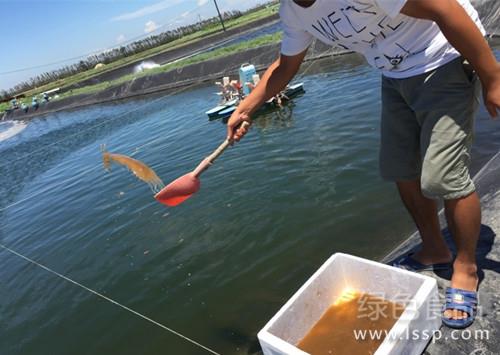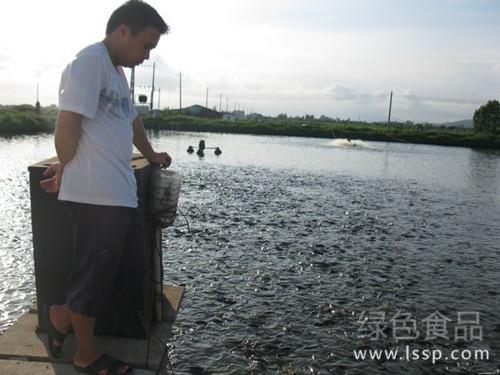If you don't have enough to eat, you can't even eat too much. Shrimp feed is very fastidious.
Feed is the main nutrient source of shrimp, but it is also the main pollution source of pond. The feeding process is the process that the water body is constantly polluted, so the feed quality determines the growth rate of shrimp and the degree of water pollution. Feed management should not only make prawns full and grow fast, but also reduce waste, reduce water pollution and reduce breeding costs. In the process of culture, if insufficient baiting, it will slow down the growth rate of shrimp, prolong the molting interval time, shrimp due to lack of nutrition, physical decline, easy to infection disease, or make shrimp individual size uneven, affecting the yield.

Shrimp feeding
If the bait is excessive, it will increase the residual bait, waste feed and increase the feed coefficient. At the same time, due to the anaerobic decomposition of too much residual bait and feces, a large number of harmful substances are produced, which spoil the water quality and sediment. In addition, due to the deterioration of the environment, it is conducive to the proliferation of pathogenic bacteria, increase the pressure of disease control, and easily cause diseases, resulting in stolen death.
First, choose high quality feed. With comprehensive nutrition and reasonable collocation, it can ensure the nutritional needs of shrimp growth, enhance shrimp disease resistance, high digestion and absorption rate, good food inducement, reduce enteritis, reduce protein content and residual bait in shrimp feces, so as to reduce water pollution.
Second, determine the amount of bait. Proper feeding is the key to the success of shrimp culture. It is also an important means to reduce breeding costs and improve efficiency, how to determine the appropriate amount of feed is the difficulty of feed management.
Shrimp culture in the outer pond, the daily feeding times, 1-7 days after release is 2 times, and then gradually adjusted to 3 Mel 4 times according to the feeding situation. The results showed that the feeding times of 3 to 15 times a day had no significant difference on the growth of shrimp. In addition, in the middle and later stage of culture, due to the large accumulation of organic matter, a large amount of oxygen is consumed, and there is no photosynthesis at night, so the dissolved oxygen in the water body in the later stage of culture is insufficient or in the state of sub-hypoxia at night, under this condition, the utilization rate of feed conversion decreased, so do not feed it at night, of course, if the culture water quality is maintained well, it can also be fed properly at night.
On the first day of seedling release, the feeding amount was 100g / 100000 times (the smaller the water body was, the less the initial feeding amount was, and the first feeding amount of about one mu of water body was 1.0kg / mu. (M), 2 times 3 times a day, and then increase by 1015% every 3 days, until the feed plate is put in 15 days later to adjust the amount of feed. Generally speaking, the amount of feed before and after cooking is 1.5kg / 100000 tails. Times (mariculture is less than freshwater culture), 3 times per day. The area of the feed plate is about 0.3 square meters and can not be eaten within the agreed time. The next feeding should be properly reduced or stopped.
The amount of feed plate is related to the area of pond, water temperature, the number of shrimp fry and so on. Take the stocking amount of 4 ~ 100000 per mu in a pond of 3 to 5 mu as an example:
Before the shrimp body length is 3 cm, 0.5% of each feeding amount is generally placed in the feed plate (0.1-0.2% in the first two days of material inspection) and inspected in 2.5 hours; No. 1 feed, about 1% of each feeding amount in the feed plate is put into the plate for 1.5 hours; No. 2 feed, 2% of each feeding amount is generally put in the tray for 1.5 hours. No. 3 feed, generally put 3% of the amount of each feed in the feed plate for 1.0 to 1.5 hours (the viewing time is calculated from the beginning of feeding). When the water temperature is low, it can be adjusted according to the weather and water quality.
Third, strengthen feed nutrition. High-quality feed can provide most of the nutrition to shrimp to meet the needs of energy consumption and body growth and metabolism of shrimp. However, due to the limitations of the production process (hard pellet feed has to go through high temperature and high pressure), feed nutrients will always be missing, especially live bacterial preparations, which can not be added basically, and vitamin C and other nutrients are easy to be lost in the process of processing and preservation. as a result, vitamins and microbial preparations are difficult to meet the needs of prawns, which need to be added separately, of course, some disease prevention and treatment drugs should be added for the treatment of diseases.
Therefore, multi-dimensional, immune polysaccharides and other nutrients are added to the feed, especially in high-density culture, in order to ensure the healthy growth of shrimp. Feed commonly used nutritional additives are: bivalent yeast, high stability C, shrimp multi-dimensional, strong growth promoter, promoting growth and so on. Strengthen feed nutrition, enhance shrimp physique, improve feed digestion and absorption rate, and reduce water pollution.
- Prev

How to save feed when raising tilapia with too much feed and worsening water
How to save feed when raising tilapia with too much feed and worsening water
- Next

How to prevent sheep disease in hot season
First, strengthen the feeding and management of summer sheep, the disease resistance is reduced, and it is easy to get sick. In order to improve the disease resistance of sheep, it is necessary to ensure the supply of sufficient nutrients for sheep, and feed concentrate once every morning and evening, 0.2kg to 0.5kg per adult sheep. Feed should be fixed and quantitative to prevent excessive or lack of nutrients. It is strictly forbidden to feed poisonous, moldy and contaminated feed. Clean drinking water should be given in time. Herding sheep in summer should go out early and return late, and let the sheep have more rest at noon to prevent heatstroke. The sheephouse should be nailed to screen doors and windows to prevent mosquitoes and flies. Second, engage in
Related
- On the eggshell is a badge full of pride. British Poultry Egg Market and Consumer observation
- British study: 72% of Britons are willing to buy native eggs raised by insects
- Guidelines for friendly egg production revised the increase of space in chicken sheds can not be forced to change feathers and lay eggs.
- Risk of delay in customs clearance Australia suspends lobster exports to China
- Pig semen-the Vector of virus Transmission (4)
- Pig semen-the Vector of virus Transmission (3)
- Five common causes of difficult control of classical swine fever in clinic and their countermeasures
- Foot-and-mouth disease is the most effective way to prevent it!
- PED is the number one killer of piglets and has to be guarded against in autumn and winter.
- What is "yellow fat pig"? Have you ever heard the pig collector talk about "yellow fat pig"?

